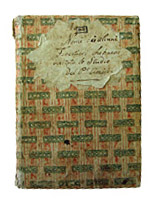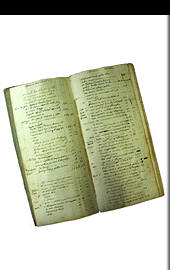Documents
Giovanni Battista Amici's Visitors' Book from June 1818 to January 1844
 From June 1818 to January 1844, Giovanni Battista Amici kept a small notebook in which he regularly wrote down the names of most of his visitors (cf. Registro dei visitatori dello Studio di Giovanni Battista Amici dal giugno 1818 al gennaio 1844 e taccuini < Register of the visitors to Giovanni Battista Amici’s Workshop Office from June 1818 to January 1844 and notebooks >, in A. Meschiari, Il Libro de’ conti del laboratorio di Giovanni Battista Amici e altri documenti inediti, Tassinari, Florence 2003).
From June 1818 to January 1844, Giovanni Battista Amici kept a small notebook in which he regularly wrote down the names of most of his visitors (cf. Registro dei visitatori dello Studio di Giovanni Battista Amici dal giugno 1818 al gennaio 1844 e taccuini < Register of the visitors to Giovanni Battista Amici’s Workshop Office from June 1818 to January 1844 and notebooks >, in A. Meschiari, Il Libro de’ conti del laboratorio di Giovanni Battista Amici e altri documenti inediti, Tassinari, Florence 2003).
It is a quite interesting document through which relationships can be reconstructed, dates for meetings or the sale of an instrument can be verified and non-dated correspondence can be organized.
From the early 1820s, along with sovereigns and royalty like Francis I, Emperor of Austria, Prince Gustav of Sweden, Leopold II of Tuscany, Maximilian of Austria, Victor Emmanuel I of Savoy and obviously the Duke of Modena Francis IV, there were other visitors like the Marquis Cosimo Ridolfi, the Canon Angelo Bellani, Professor Giorgini, Vincenzo Antinori. Then there were the astronomers Plana, Santini, Carlini, Ciccolini, Cesaris. And later the names of Vieusseux, Corridi, Mary Somerville, and the Geneva physicist Marc-Auguste Pictet, the Viennese astronomer Karl Ludwig von Littrow, the naturalist and philosopher of nature Lorenz Oken and the astronomer Adolphe Quetelet, scientists who had come to Tuscany for the Scientific Meetings.
More particularly, in July of 1820 there is the name of Antonio Scarpa (1752-1832) from Pavia, anatomist and surgeon, friend of Volta and of Spallanzani, at that time Professor of Anatomy in Modena. In September of the same year Amici received a visit from the astronomer from Gotha Baron Franz Xaver von Zach (1754-1832), who played an important part in making the instruments and the astronomical observations of Amici known through the pages of the “Correspondance astronomique, hydrographique et statistique”, published in Genoa.
 Scarpa and von Zach were portrayed by Amici with the use of the camera lucida, as were many of his guests. The Estense Library in Modena has more than 400 such portraits done by him.
Scarpa and von Zach were portrayed by Amici with the use of the camera lucida, as were many of his guests. The Estense Library in Modena has more than 400 such portraits done by him.
The entries in this register permit the confirmation of two of the three visits from William Henry Fox Talbot (1800-1877), that of 16 September 1822 and the one of 22 March 1826: the beginning of a relationship which would leave its mark on the history of photography.
John Frederik William Herschel (1792-1871) was in Modena twice in 1824, on 29 April and then at the end of summer. The English astronomer, who greatly appreciated Amici’s reflector telescopes, brought one of Amici’s double image micrometers with him to London in order to present it at the first meeting of the Astronomical Society.
During the same summer there was a visit from the Abate Antonio Rosmini (1797-1855) of Rovereto. In February 1827 the astronomer Captain Wilhelm von Biela (1782-1856) came in visit, and the English mathematician, Charles Babbage (1792-1871), came to Modena in January of 1828 and remained there for about a month.
George Biddel Airy’s (1801-1892) name appears on 26 September 1829; in 1835 he would become the Astronomer Royal (title given to the astronomers in Greenwich). He would play an important role in the creation of the hemispherical front lens, helping Amici procure flint glass of great dispersive power from Faraday.
On 10 May 1833 among the visitors to the Florence workshop there was also Mr. Emerson from Boston. Protestant minister, writer, moralist, philosopher and poet, Ralph Waldo Emerson (1803-1882) wrote in his diary about this visit:
“May 10. Visited Professor Amici and saw his optical instruments. He is reputed the maker of the best microscopes in Europe. He has also made a telescope for Herschel in London. He has a microscope whose magnifying power is 6000 diameters, or 36,000,000 superficies. To instruments of this enormous power he applies the camera lucida and then draws the outline of the object with pencil. His experiments upon polarized light are beautiful. The price of his best instruments is 800 francs. He has just made one for Dr. Jarvis for $45” (Journals of Ralph Waldo Emerson <1820-1876>, in 10 vol., edited by Edward Waldo Emerson and Waldo Emerson Forbes, Boston and New York, 1909-1914, vol. III-1910).
In November of 1833 the Navy captain Basil Hall (1788-1844) visited Amici in Florence. In November of 1837 the Rev. Thomas Romney Robinson (1792-1882), director of the Astronomical Observatory of Armagh in Ireland, visited. He would subsequently send Amici’s prism reflecting circle on the Antarctic expedition of James Clark Ross.
 In May 1840 the name of the English captain and arctic navigator George Back (1796-1878) is entered; he accompanied John Franklin once in 1818 and then in a first and second exploratory trip to the arctic regions. And then there is the Swiss geologist Bernhard Studer (1794-1887), who together with A. Escher von der Linth drew up the first geological map of Switzerland. In November there is the name of the English philologist and mathematician Alexander John Ellis (1814-1890), who produced a daguerreotype of Ponte alle Grazie seen from the Demidoff Palace in via de’Renai, i.e., from the residence of the Amicis.
In May 1840 the name of the English captain and arctic navigator George Back (1796-1878) is entered; he accompanied John Franklin once in 1818 and then in a first and second exploratory trip to the arctic regions. And then there is the Swiss geologist Bernhard Studer (1794-1887), who together with A. Escher von der Linth drew up the first geological map of Switzerland. In November there is the name of the English philologist and mathematician Alexander John Ellis (1814-1890), who produced a daguerreotype of Ponte alle Grazie seen from the Demidoff Palace in via de’Renai, i.e., from the residence of the Amicis.

